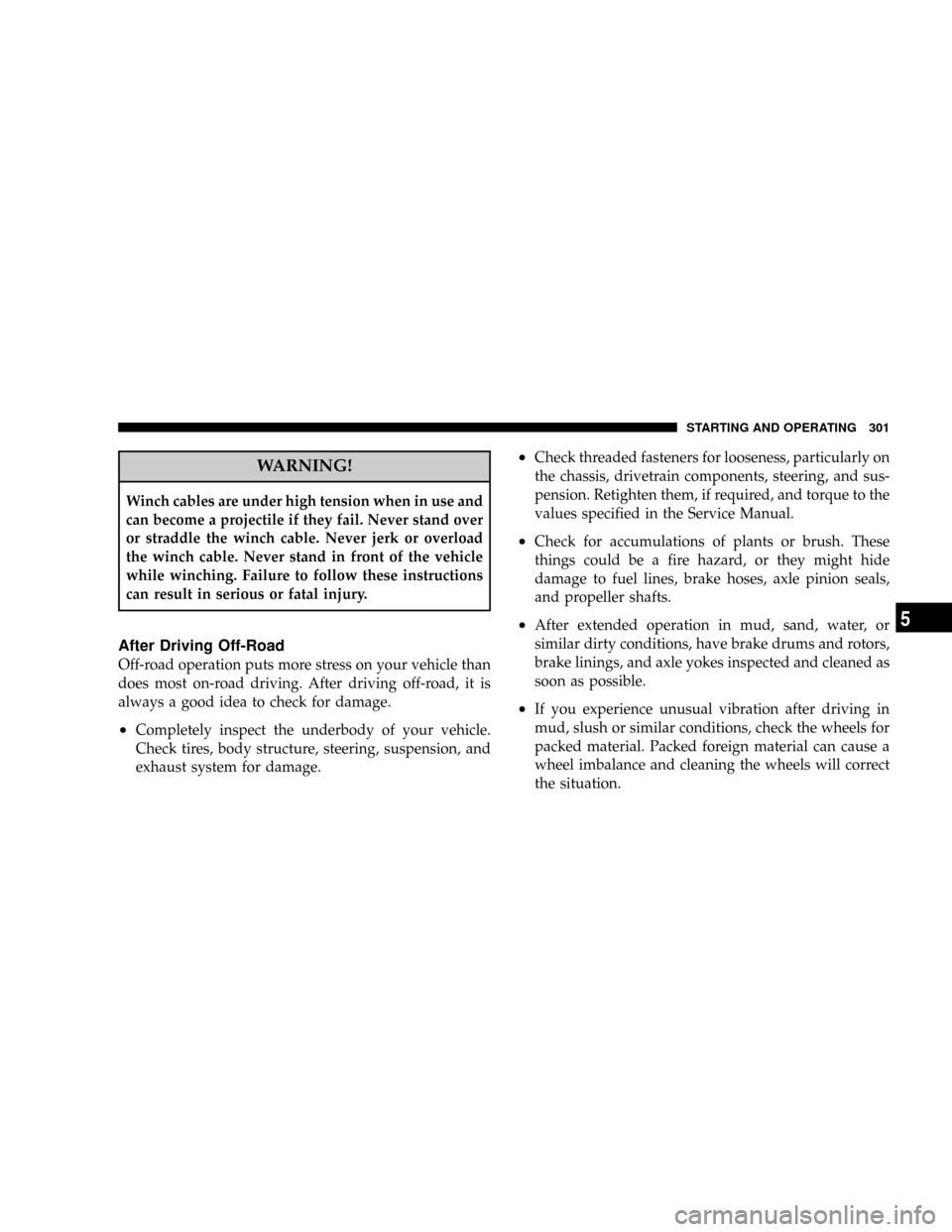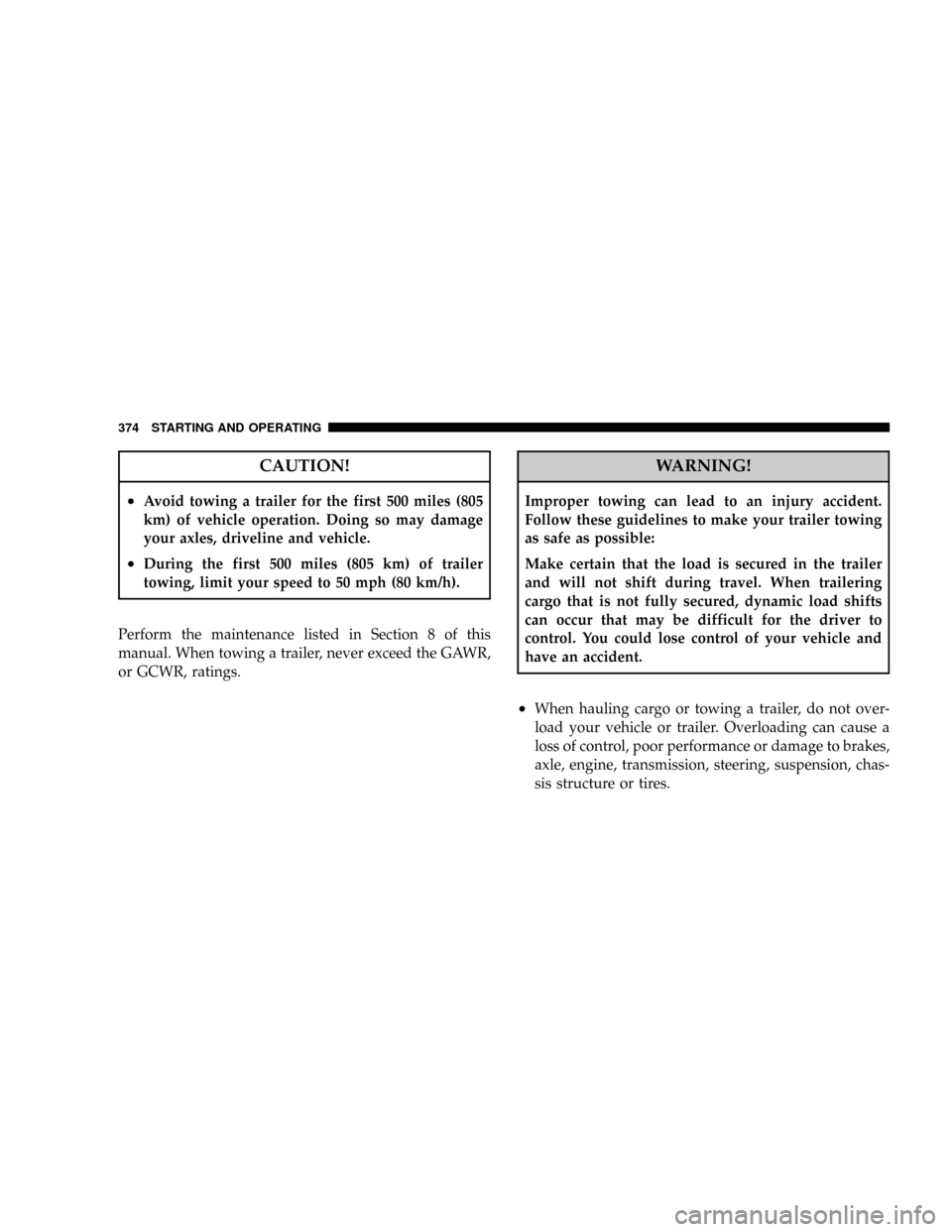2008 DODGE RAM 2500 POWER WAGON suspension
[x] Cancel search: suspensionPage 86 of 504

High-Pressure Monotube Shocks/New Front and
Rear Springs
The new variable-rate shocks and revised springs help to
create a suitable on-road ride without compromising
off-road competency. The shocks are designed to provide
improved stability, durability, and suspension articula-
tion.
Off-Road Tires
These tires are specifically designed for extreme off-road
use, while also maintaining quite on-road operation. The
tires utilize long-life compounds for increased durability,
and a deep-groove tread for extra traction. The LT285/
70R17D used provides a large contact patch for better
traction, two full-width steel belts for improved strength,
as well as a reinforced sidewall to help protect against
bruising and shredding.
Skid Plates And Underbody Protection
Steel skid plates protect the major driveline components
of the truck including the fuel tank, transfer case and
steering damper. In addition the Power Wagon is
equipped with boxed cross members and fore/aft rails.
This additional protection allows the vehicle to be uti-
lized in severe off-road situations that would be consid-
ered impassable by a normal truck.
Wheel Flares
Not just for looks, the wheel flares on the Power Wagon
were designed to help cover its new larger off-road tires.
The larger flares also help to reduce the amount of debris
that can be flung up by the more aggressive tread pattern
on the tires.
86 UNDERSTANDING THE FEATURES OF YOUR VEHICLE
Page 88 of 504

²Off-Road Tuned Suspension And Shocks - improves
mobility, ground clearance and ride comfort.
²Heavy Duty Thermally Protected and Sealed Electric
Winch with Roller Fairlead - Useful for work and
vehicle recovery.
²17 Inch Forged Aluminum Wheels With 33 Inch Tires
- improves traction and differential ground clearance.
Mopar Options:
²
Rock Rails - protects the door sills from impingement
damage and provides a vehicle jacking point.
²Winch accessory kit - Contents include:
²Snatch Block/Pulley
²Clevis
²Tree strap
²Tow Strap
²Gloves
²ªPower Wagon embossedº storage bag
²Bed Liner - protects the bed from impingement dam-
age
NOTE:These Mopar options have been specially de-
signed and tested for the Power Wagon to meet the
vigorous off-road conditions.
MIRRORS
Inside Mirror
The mirror should be adjusted to center on the view
through the rear window.
Annoying headlight glare can be reduced by moving the
small control under the mirror to the night position
(toward rear of vehicle). The mirror should be adjusted
while set in the day position (toward windshield).
88 UNDERSTANDING THE FEATURES OF YOUR VEHICLE
Page 279 of 504

NOTE:The rear axle must be locked before the front
axle will lock.
To unlock the front axle move the axle locker switch to
REAR LOCK. The FRONT/REAR indicator light will go
out when the axle is unlocked.
NOTE:The axle lockers could be torque locked due to
side to side loads on the axle. Driving slowly while
turning the steering wheel from a left hand turn to a right
hand turn or driving in reverse for a short distance may
be required to release the torque lock and unlock the
axles.
To unlock the rear axle move the axle locker switch to
AXLE UNLOCK. The REAR LOCK indicator light will go
out when the rear axle is unlocked.Stabilizer/Sway Bar System
Power Wagon vehicles are equipped with an electronic
disconnecting stabilizer/sway bar. This system allows
greater front suspension travel in off-road situations.
This system is controlled by the electronic control sway
bar switch located on the instrument panel.
Electronic Control Sway Bar Switch
STARTING AND OPERATING 279
5
Page 280 of 504

The switch has two positions, on-road and off-road. The
system is normally in on-road mode, indicated by a solid
green light. The stabilizer/sway bar should remain in
on-road mode during normal driving conditions.
WARNING!
Do not disconnect the stabilizer bar and drive on
hard surfaced roads or at speeds above 18 MPH, you
may lose control of the vehicle, which could result in
serious injury. The front stabilizer bar enhances
vehicle stability and is necessary for maintaining
control of the vehicle. The system monitors vehicle
speed and will attempt to reconnect the stabilizer bar
at speeds over 18 MPH. This is indicated by a
flashing off road light and solid on road light. Once
vehicle speed is reduced below 14 MPH the system
will once again attempt to return to off road mode.To disconnect the stabilizer/sway bar, shift to either 4HI
or 4LO as shown in Four Wheel Drive Operation and
press the top of the stabilizer/sway bar button to obtain
the off-road position. The amber indicator light will flash
until the stabilizer/sway bar has been fully disconnected.
NOTE:The stabilizer/sway bar may be torque locked
due to left and right suspension height differences. This
condition is due to driving surface differences or vehicle
loading. In order for the stabilizer/sway bar to
disconnect/reconnect, the right and left halves of the bar
must be aligned. This alignment may require that the
vehicle be driven onto level ground or rocked from side
to side.
To return to on-road mode press the bottom of the
stabilizer/sway bar button.
280 STARTING AND OPERATING
Page 301 of 504

WARNING!
Winch cables are under high tension when in use and
can become a projectile if they fail. Never stand over
or straddle the winch cable. Never jerk or overload
the winch cable. Never stand in front of the vehicle
while winching. Failure to follow these instructions
can result in serious or fatal injury.
After Driving Off-Road
Off-road operation puts more stress on your vehicle than
does most on-road driving. After driving off-road, it is
always a good idea to check for damage.
²Completely inspect the underbody of your vehicle.
Check tires, body structure, steering, suspension, and
exhaust system for damage.
²Check threaded fasteners for looseness, particularly on
the chassis, drivetrain components, steering, and sus-
pension. Retighten them, if required, and torque to the
values specified in the Service Manual.
²Check for accumulations of plants or brush. These
things could be a fire hazard, or they might hide
damage to fuel lines, brake hoses, axle pinion seals,
and propeller shafts.
²After extended operation in mud, sand, water, or
similar dirty conditions, have brake drums and rotors,
brake linings, and axle yokes inspected and cleaned as
soon as possible.
²If you experience unusual vibration after driving in
mud, slush or similar conditions, check the wheels for
packed material. Packed foreign material can cause a
wheel imbalance and cleaning the wheels will correct
the situation.
STARTING AND OPERATING 301
5
Page 343 of 504

WARNING!
²Do not use a tire, wheel size or rating other than that
specified for your vehicle. Some combinations of
unapproved tires and wheels may change suspension
dimensions and performance characteristics, result-
ing in changes to steering, handling, and braking of
your vehicle. This can cause unpredictable handling
and stress to steering and suspension components.
You could lose control and have an accident resulting
in serious injury or death. Use only the tire and wheel
sizes with load ratings approved for your vehicle.
²Never use a tire with a smaller load index or capacity,
other than what was originally equipped on your
vehicle. Using a tire with a smaller load index could
result in tire overloading and failure. You could lose
control and have an accident.
²Failure to equip your vehicle with tires having ad-
equate speed capability can result in sudden tire
failure and loss of vehicle control.
CAUTION!
Replacing original tires with tires of a different size
may result in false speedometer and odometer
readings.
Alignment And Balance
Poor suspension alignment may result in:
²Fast tire wear.
²Uneven tire wear, such as feathering and one-sided
wear.
²Vehicle pull to right or left.
Tires may also cause the vehicle to pull to the left or right.
Alignment will not correct this condition. See your dealer
for proper diagnosis.
STARTING AND OPERATING 343
5
Page 365 of 504

Each axle GAWR is determined by the components in the
system with the lowest load carrying capacity (axle,
springs, tires or wheels). Heavier axles or suspension
components sometimes specified by purchasers for in-
creased durability does not necessarily increase the vehi-
cle's GVWR.
Tire Size
The tire size on the Label represents the actual tire size on
your vehicle. Replacement tires must be equal to the load
capacity of this tire size.
Rim Size
This is the rim size that is appropriate for the tire size
listed.
Inflation Pressure
This is the cold tire inflation pressure for your vehicle for
all loading conditions up to full GAWR.
Curb Weight
The curb weight of a vehicle is defined as the total weight
of the vehicle with all fluids, including vehicle fuel, at full
capacity conditions, and with no occupants or cargo
loaded into the vehicle. The front and rear curb weight
values are determined by weighing your vehicle on a
commercial scale before any occupants or cargo are
added.
Loading
The actual total weight and the weight of the front and
rear of your vehicle at the ground can best be determined
by weighing it when it is loaded and ready for operation.
The entire vehicle should first be weighed on a commer-
cial scale to insure that the GVWR has not been exceeded.
The weight on the front and rear of the vehicle should
then be determined separately to be sure that the load is
properly distributed over front and rear axle. Weighing
the vehicle may show that the GAWR of either the front
STARTING AND OPERATING 365
5
Page 374 of 504

CAUTION!
²Avoid towing a trailer for the first 500 miles (805
km) of vehicle operation. Doing so may damage
your axles, driveline and vehicle.
²During the first 500 miles (805 km) of trailer
towing, limit your speed to 50 mph (80 km/h).
Perform the maintenance listed in Section 8 of this
manual. When towing a trailer, never exceed the GAWR,
or GCWR, ratings.
WARNING!
Improper towing can lead to an injury accident.
Follow these guidelines to make your trailer towing
as safe as possible:
Make certain that the load is secured in the trailer
and will not shift during travel. When trailering
cargo that is not fully secured, dynamic load shifts
can occur that may be difficult for the driver to
control. You could lose control of your vehicle and
have an accident.
²When hauling cargo or towing a trailer, do not over-
load your vehicle or trailer. Overloading can cause a
loss of control, poor performance or damage to brakes,
axle, engine, transmission, steering, suspension, chas-
sis structure or tires.
374 STARTING AND OPERATING